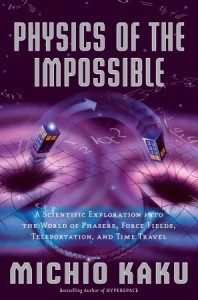Nov
8
Future Science: Redefining the Impossible
“Shields up! Ahead warp factor three, Mr. Sulu.”
“Aye, sir. Ahead Warp 3…”
If you are a science fiction buff like me, no doubt you enjoy all of the fantastic weapons, tools, and other gizmos at our heroes’ disposal. (Unless, of course, the story is about some sort of apocalypse or dystopia where such things are rare or non-existent.) I don’t know about you, but I would love to be able to teleport, time travel, or take a starship through hyperspace! But, we call these stories and the futuristic technologies used in them “science fiction” (or, “speculative fiction”, to use the old term) for a reason: it can’t be done. Or, at least, not yet.
 A book I have been perusing lately is Physics of the Impossible: A Scientific Exploration into the World of Phasers, Force Fields, Teleportation, and Time Travel (2008) by theoretical physicist Michio Kaku. (You may have seen Kaku on one of his many appearances on science-related TV shows.) It’s an enjoyable read, and his references to pop-culture are fun, though he sometimes gets things slightly wrong. (For example, he states that Star Trek IV involves time travel back to the 1960s, when it was actually the 1980s. Typo? He also misunderstands how the universal translator device in Star Trek is supposed to work.)
A book I have been perusing lately is Physics of the Impossible: A Scientific Exploration into the World of Phasers, Force Fields, Teleportation, and Time Travel (2008) by theoretical physicist Michio Kaku. (You may have seen Kaku on one of his many appearances on science-related TV shows.) It’s an enjoyable read, and his references to pop-culture are fun, though he sometimes gets things slightly wrong. (For example, he states that Star Trek IV involves time travel back to the 1960s, when it was actually the 1980s. Typo? He also misunderstands how the universal translator device in Star Trek is supposed to work.)
As you might gather from the sub-title, Kaku looks at many different science-fictional technologies found in our favorite books, TV series, and movies, and uses current scientific knowledge and speculation to determine the likelihood of that tech ever becoming a reality.
“[I]t seems probable that most of the grand underlying principles have been firmly established…. An eminent physicist remarked that the future truths of physical science are to be looked for in the sixth place of decimals.”
— Albert A. Michelson (1894), first American to receive a Nobel Prize in the sciences (specifically in Physics)
As brilliant as he was, Dr. Michelson was a bit overconfident about what there was to know and short-sighted when it came to anticipating scientific progress. He wasn’t the only one in history to make such mistakes, though. (If you’re curious, look up infamous quotes by U.S. Postmaster General John Wanamaker and IBM chairman Thomas J. Watson.)
In the preface to the book, Kaku speaks of his own childhood fascination with science-fiction, which inspired him to study advanced mathematics and theoretical physics. He also notes that, even in his relatively short lifetime, “I have seen the seemingly impossible become established scientific fact over and over again. So is it impossible to think we might one day be able to teleport ourselves from one place to another, or build a spaceship that will one day take us light-years away to the stars?”
Later, he continues enthusiastically…
“Time and again we see that the study of the impossible has opened up entirely new vistas, pushing the boundaries of physics and chemistry and forcing scientists to redefine what they mean by ‘impossible.’…
It is always a bit dangerous to make predictions, especially ones set centuries to thousands of years in the future. The physicist Niels Bohr was fond of saying ‘Prediction is very hard to do. Especially about the future.’ But there is a fundamental difference between the time of Jules Verne and the present. Today the fundamental laws of physics are basically understood. Physicists today understand the basic laws extending over a staggering forty-three orders of magnitude, from the interior of the proton out to the expanding universe. As a result, physicists can state, with reasonable confidence, what the broad outlines of future technology might look like, and better differentiate between those technologies that are merely improbable and those that are truly impossible.
In this book, therefore, I divide the things that are ‘impossible’ into three categories.
The first are what I call Class I impossibilities. These are technologies that are impossible today but that do not violate the known laws of physics. So they might be possible in this century, or perhaps the next, in modified form. They include teleportation, antimatter engines, certain forms of telepathy, psychokinesis, and invisibility.
The second category is what I term Class II impossibilities. These are technologies that sit at the very edge of our understanding of the physical world. If they are possible at all, they might be realized on a scale of millennia to millions of years in the future. They include time machines, the possibility of hyperspace travel, and travel through wormholes.
The final category is what I call Class III impossibilities. These are technologies that violate the known laws of physics. Surprisingly, there are very few such impossible technologies. If they do turn out to be possible, they would represent a fundamental shift in our understanding of physics.
This classification is significant, I feel, because so many technologies in science fiction are dismissed by scientists as being totally impossible, when what they actually mean is that they are impossible for a primitive civilization like ours. Alien visitations, for example, are usually considered impossible because the distances between the stars are so vast. While interstellar travel for our civilization is clearly impossible, it may be possible for a civilization centuries to thousands or millions of years ahead of ours. So it is important to rank such ‘impossibilities.’ Technologies that are impossible for our current civilization are not necessarily impossible for other types of civilizations. Statements about what is possible and impossible have to take into account technologies that are millennia to millions of years ahead of ours.”
It is not surprising that Kaku’s materialist/reductionist perspective is reflected in his writing, in some of his presumptions, but it is not overbearing. While religious figures and the Bible are mentioned in a few places (e.g., the account of Philip’s “teleportation” in Acts 8:36-40), it is for historical purposes and without the condescension or derision that often accompanies such references in the writings of his peers. What is a bit surprising is that there is little discussion of ethical considerations in scientific research, considering that Kaku is known to be an anti-nuclear activist and concerned with the general misuse of science.
I may not be as optimistic as Kaku, but the possibilities are intriguing. Constantly theorizing and investigating the nature of Creation (ahem!) has proven to be a worthwhile endeavor on many levels. As long as we do so ethically, safely, and with financial responsibility, I see no reason why we shouldn’t continue exploring and pushing the bounds of our knowledge of what is possible. Eventually, if (God willing) civilization survives long enough, odds are we will break through into the Class I, maybe even Class II, realms of “impossibility”. It’s sure to be an exciting ride!
P.S. I haven’t seen it, but apparently the Science Channel produced a 12-episode series called Sci Fi Science: Physics of the Impossible, hosted by Kaku and based on the above book. I wonder if my library has a copy….
















